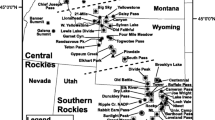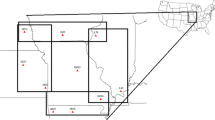Abstract
National Atmospheric Deposition Program (NADP)/National Trends Network precipitation type, snow-season duration, and annual timing of selected chemical wet-deposition maxima vary with latitude and longitude within a 35-year (1979–2013) data record for the contiguous United States and Alaska. From the NADP data collected within the region bounded by 35.6645°–48.782° north latitude and 124°–68° west longitude, similarities in latitudinal and longitudinal patterns of changing snow-season duration, fraction of annual precipitation recorded as snow, and the timing of chemical wet-deposition maxima, suggest that the chemical climate of the atmosphere is linked to physical changes in climate. Total annual precipitation depth has increased 4–6 % while snow season duration has decreased from approximately 7 to 21 days across most of the USA, except in higher elevation regions where it has increased by as much as 21 days. Snow-season precipitation is increasingly comprised of snow, but annually total precipitation is increasingly comprised of liquid precipitation. Meanwhile, maximum ammonium deposition occurs as much as 27 days earlier, and the maximum nitrate: sulfate concentration ratio in wet-deposition occurs approximately 10–21 days earlier in the year. The maximum crustal (calcium + magnesium + potassium) cation deposition occurs 2–35 days earlier in the year. The data suggest that these shifts in the timing of atmospheric wet deposition are linked to a warming climate, but the ecological consequences are uncertain.







Similar content being viewed by others
References
Bailey RB (1998) Ecoregions: the ecosystem geography of the oceans and continents. Springer, New York
Boonpragob K, Nash TH, Fox CA (1989) Seasonal deposition patterns of acidic ions and ammonium to the lichen Ramalina Menziesii Tayl. in Southern California. Environ Exp Bot 29(2):187–197
Bowersox VC, de Pena RG (1980) Analysis of precipitation chemistry at a Central Pennsylvania Site. J Geophys Res 85(C10):5614–5620
Burakowski EA, Wake CP, Braswell B, Brown DP (2008) Trends in wintertime climate in the northeastern United States: 1965–2005. J Geophys Res. doi:10.1029/2008JD009870
Burns DA (2004) The effects of atmospheric nitrogen deposition in the Rocky Mountains of Colorado and southern Wyoming, USA—a critical review. Environ Pollut 127:257–269
Cadle SH (1985) Seasonal variations in nitric acid, nitrate, strong aerosol acidity, and ammonia in an urban area. Atmos Environ 19(1):181–188
Caiazza R, Hage KD, Gallup D (1978) Wet and dry deposition of nutrients in central Alberta. Water Air Soil Pollut 1978:309–314
Cayan DR, Kammerdiener SA, Dettinger MD, Caprio JM, Peterson DH (2001) Changes in the onset of spring in the western United States. Bull Am Meteorol Soc 82(3):399–415
Clow DW, Mast MA (1999) Long-term trends in stream water and precipitation chemistry at five headwater basins in the northeastern United States. Water Resour Res 35(2):541–554
Colbeck SC (1981) A simulation of the enrichment of atmospheric pollutants in snow cover runoff. Water Resour Res 17(5):1383–1388
Coopersmith EJ, Minsker BS, Sivapalan M (2014) Patterns of regional hydroclimatic shifts: an analysis of changing hydrologic regimes. Water Resour Res 50:1960–1983. doi:10.1002/2012WR013320
Dasch JM (1987) On the difference between SO4 2− and NO3 − in wintertime precipitation. Atmos Environ 21(1):137–141
Dye DG (2002) Variability and trends in annual snow-cover cycle in Northern Hemisphere land areas, 1972–2000. Hydrol Process 16:3065–3077
Easterling DR (2002) Recent changes in frost-free days and the frost-free season in the United States. Bull Am Meteorol Soc 83:1327–1332
Easterling DR, Meehl GA, Parmesan C, Changnon SA, Karl TR, Mearns LO (2000) Climate extremes: observations, modeling, and impacts. Science 289:2068–2074
Feng S, Hu Q (2007) Changes in winter snowfall/precipitation ratio in the contiguous United States. J Geophys Res Atmos 112:D15109
Fenn ME, Haeuber R, Tonnesen GS, Baron JS, Grossman-Clarke S, Hope D, Jaffe DA, Copeland S, Geiser L, Rueth HM, Sickman JO (2003) Nitrogen emissions, deposition, and monitoring in the Western United States. Bioscience 53(4):391–403
Gienapp P, Leimu R, Merila J (2007) Response to climate change in avian migration time—microevolution versus phenotypic plasticity. Clim Res 35:25–35
Golden HE, Boyer EW (2009) Contemporary estimates of atmospheric nitrogen deposition to the watersheds of New York State, USA. Environ Monit Assess 155:319–339. doi:10.1007/s10661-008-0438-8
Groisman PY, Easterling DR (1994) Variability and trends of total precipitation and snowfall over the United States and Canada. J Clim 7:184–205
Groisman PY, Knight RW, Easterling DR, Karl TR, Hegerl GC, Razuvaev VN (2005) Trends in intense precipitation in the climate record. J Clim 18:1326–1350
Helsel DR, Mueller DK, Slack JR (2005) The Kendal family of trends, USGS Scientific Investigations Report 2005–5275. http://pubs.usgs.gov/sir/2005/5275/. Accessed 14 Oct 2014
Heuer K, Tonnessen KA, Ingersoll GP (2000) Comparison of precipitation chemistry in the Central Rocky Mountains, Colorado, USA. Atmos Environ 34(2000):1713–1722
Hodgkins GA, Dudley RW, Huntington TG (2003) Changes in the timing of high river flows in New England over the 20th century. J Hydrol 278(1–4):244–252
Huntington TG, Hodgkins GA, Dudley RW (2003) Historical trends in river ice thickness and coherence in hydroclimatological trends in Maine. Clim Change 61:217–236
Huntington TG, Keim BD, Dudley RW (2004) Changes in the proportion of precipitation occurring as snow in New England (1949–2000). J Clim 17:2626–2636
Irwin JG, Williams MW (1988) Acid rain: chemistry and transport. Environ Pollut 50(1988):29–59
Kapnick S, Hall A (2010) Observed climate-snowpack relationships in California and their implications for the future. J Clim 23:3446–3456
Karl TR, Groisman PY, Knight RW, Heim RR Jr (1993) Recent variations of snow cover and snowfall in North America and their relation to precipitation and temperature variations. J Clim 6:1327–1344
Knowles N, Dettinger MD, Cayan DR (2006) Trends in snowfall versus rainfall for the Western United States. J Clim 19:4545–4559
Kunkel KE, Easterling DR, Kristovich AR, Gleason B, Stoecker L, Smith R (2012) Meteorological causes of the secular variations in observed extreme precipitation events for the conterminous United States. J Hydrometeorol 13:1131–1141
Lebowitz LG, de Pena RG (1985) Chloride and sodium content in Northeastern United States precipitation. J Geophys Res 90(D5):8149–8154
Lehmann CMB, Bowersox VC, Larson SM (2005) Spatial and temporal trends of precipitation chemistry in the United States, 1985–2002. Environ Pollut 135(2005):347–361
Lehmann CMB, Bowersox VC, Larson RS, Larson SM (2007) Monitoring long-term trends in sulfate and ammonium in US precipitation: results from the National Atmospheric Deposition Program/National Trends Network. Water Air Soil Pollut Focus 7:59–66. doi:10.1007/s11267-006-9100-z
Lettenmaier DP, Wood EF, Wallis JR (1994) Hydro-climatological trends in the continental United States, 1948–88. J Clim 7:586–607
Likens GE, Bormann FH, Pierce RS, Eaton JS, Munn RE (1984) Long-term trends in precipitation chemistry at Hubbard Brook, New Hampshire. Atmos Environ 18(12):2641–2647
Lovett GM (1994) Atmospheric deposition of nutrients and pollutants in North America: an ecological perspective. Ecol Appl 4(4):629–650. doi:10.2307/1941997
Mast MA, Turk JT, Clow DW, Campbell DH (2011) Response of lake chemistry to changes in atmospheric deposition and climate in three high-elevation wilderness areas of Colorado. Biogeochemistry 103:27–43
Mote PW (2003) Trends in snow water equivalent in the Pacific Northwest and their climatic causes. Geophys Res Lett 30(12):1601. doi:10.1029/2003GL017258
Mote PW (2006) Climate-driven variability and trends in mountain snowpack in western North America. J Clim 19:6209–6220. doi:10.1175/JCLI3971.1
National Atmospheric Deposition Program (1999) National Trends Network Site Operations Manual, NADP Manual 1999-01c (revised). http://nadp.sws.uiuc.edu/lib/manuals/opman.pdf. Accessed 14 Oct 2014
National Atmospheric Deposition Program (2011) NADP Network Quality Assurance Plan, NADP Network QAP, Revised 2011-05, Version 1.5. http://nadp.sws.uiuc.edu/lib/qaplans/NADP_Network_Quality_Assurance_Plan.pdf. Accessed 14 Oct 2014
National Atmospheric Deposition Program (2014a) quality assurance reports. http://nadp.sws.uiuc.edu/lib/. Accessed 14 Oct 2014
National Atmospheric Deposition Program (2014b) Quality Assurance Plan, Central Analytical Laboratory, NADP QA Plan 2014-01. http://nadp.sws.uiuc.edu/lib/qaplans/qapCal2014.pdf. Accessed 14 Oct 2014
National Atmospheric Deposition Program (2014c) Central Analytical Laboratory procedures. http://nadp.isws.illinois.edu/cal/summary_of_procedures.html. Accessed 14 October 2014
National Atmospheric Deposition Program (2014d) Quality assurance plans. http://nadp.sws.uiuc.edu/lib/qaPlans.aspx. Accessed 14 Oct 2014
National Atmospheric Deposition Program (2015b) Ammonia Monitoring Network data. http://nadp.sws.uiuc.edu/data/AMoN/. Accessed 10 July 2015
National Atmospheric Deposition Program (2015a) National Trends Network data. http://nadp.sws.uiuc.edu/data/NTN. Accessed 14 Oct 2014
National Atmospheric Deposition Program/Central Analytical Laboratory (2008) Quality Assurance Report, National Atmospheric Deposition Program 2003–2004. http://nadp.sws.uiuc.edu/lib/qa/qa2003-2004.pdf. Accessed 16 July 2015
Oyler JW, Ballantyne A, Jencso K, Sweet M, Running SW (2015) Creating a topoclimatic daily air temperature dataset for the conterminous United States using homogenized station data and remotely sensed land skin temperature. Int J Climatol 35:2258–2279. doi:10.1002/joc.4127
Parmesan C (2006) Ecological and evolutionary responses to recent climate change. Annu Rev Ecol Evol Syst 37(2006):637–669
Portmann RW, Solomon S, Hegerl GC (2009) Spatial and seasonal patterns in climate change temperatures, and precipitation across the United States. Proc Natl Acad Sci 106:7324–7329. doi:10.1073/pnas.0808533106
Pratt GC, Krupa SV (1983) Seasonal trends in precipitation chemistry. Atmos Environ 17(9):1845–1847
Pryor SC, Barhelmie RJ, Sorensen LL, Jensen B (2001) Ammonia concentrations and fluxes over a forest in the Midwestern USA. Atmos Environ 35(2001):5645–5656
Psenner R (1999) Living in a dusty world: airborne dust as a key factor for alpine lakes. Water Air Soil Pollut 112:217–227
Pye HOT, Liao H, Wu S, Mickley LJ, Jacob DJ, Henze DK, Seinfeld JH (2009) Effects of changes in climate and emissions on future sulfate-nitrate-ammonium aerosol levels in the United States. J Geophys Res 114(18):D01205. doi:10.1029/2008JD010701
Rattray G, Sievering H (2001) Dry deposition of ammonia, nitric acid, ammonium, and nitrate to alpine tundra at Niwot Ridge, Colorado. Atmos Environ 35(2001):1105–1109
Raynor GS, Hayes JV (1982) Variation in chemical wet deposition with meteorological conditions. Atmos Environ 16(7):1647–1656
Robarge WP, Walker JT, McCulloch RB, Murray G (2002) Atmospheric concentrations of ammonia and ammonium at an agricultural site in the southeast United States. Atmos Environ 36(2002):1661–1674
Tarnay L, Gertler AW, Blank RR, Taylor GE Jr (2001) Preliminary measurements of summer nitric acid and ammonia concentrations in the Lake Tahoe Basin air-shed: implications for dry deposition of atmospheric nitrogen. Environ Pollut 113(2001):145–153
Topol LE (1986) Differences in ionic compositions and behavior in winter rain and snow. Atmos Environ 20(2):347–355
Topol LE, Vijayakumar R, McKinley CM, Waldron TL (1986) The effect of season and synoptic storm type on precipitation chemistry. J Air Pollut Control Assoc 36(4):393–398
U.S. Environmental Protection Agency (2014) Climate change indicators in the United States, 2014, 3rd edn. EPA 430-R-14-004: www.epa.gov/climatechange/indicators
Walther G-R, Post E, Convey P, Menzel A, Parmesan C, Beebee TJC, Fromentin J-M, Hoegh-Guldberg O, Bairlein F (2002) Ecological responses to recent climate change. Nature 416:389–395
Wetherbee GA, Latysh NE, Gordon JD (2004) External quality-assurance results for the National Atmospheric Deposition Program/National Trends Network, 2000–2001, U.S. Geological Survey Scientific Investigations Report 2004-5034, p 59
Wetherbee GA, Rhodes MF, Martin RA (2010) Comparison of precipitation-depth measurements for Belfort Model 5-780, ETI Noah-IV, and OTT Pluvio-N rain gages for the National Atmospheric Deposition Program. In: Proceedings of the 2010 annual meeting and scientific symposium: networking the networks. University of Illinois, Illinois State Water Survey, Champaign, p 104
Wetherbee GA, Rhodes MF, Ludtke AS (2013) Statistical comparison of OTT Pluvio-2 and Belfort 5-780 weekly precipitation records. In: Proceedings of the 2013 annual meeting and scientific symposium: western monitoring and analysis. University of Illinois, Illinois State Water Survey, Champaign, p 130
Williams A, Stensland GJ, Peters CR, Osborne J (2000) Atmospheric Dispersion Study of Deicing Salt Applied to Roads: Fist Progress Report, Contract Report no. 2000-05: 25. Illinois State Water Survey, Champaign, Illinois
Williams MW, Losleben M, Caine N, Greenland D (2005) Changes in climate and hydrochemical responses in a high-elevation catchment in the Rocky Mountains USA. Limnol Oceanogra 41(5):939–946
Acknowledgments
George F. Ritz (USGS) and Thomas G. Huntington (USGS) are gratefully acknowledged for their invaluable technical and editorial reviews of the manuscript. Jill Baron (USGS) provided appreciated technical consultation. Four anonymous reviewers are acknowledged for significant improvements to this study and the manuscript. Funding was provided by the U.S. Geological Survey Hydrologic Networks and Analysis Program.
Author information
Authors and Affiliations
Corresponding author
Additional information
Any use of trade, firm, or product names is for descriptive purposes only and does not imply endorsement by the U.S. Government.
Electronic supplementary material
Below is the link to the electronic supplementary material.
Rights and permissions
About this article
Cite this article
Wetherbee, G.A., Mast, M.A. Annual variations in wet-deposition chemistry related to changes in climate. Clim Dyn 47, 3141–3155 (2016). https://doi.org/10.1007/s00382-016-3017-7
Received:
Accepted:
Published:
Issue Date:
DOI: https://doi.org/10.1007/s00382-016-3017-7




